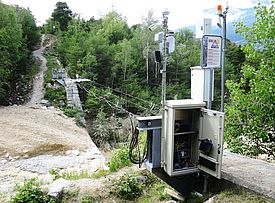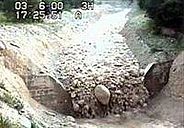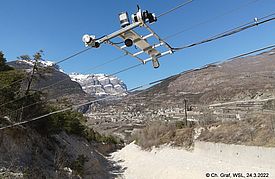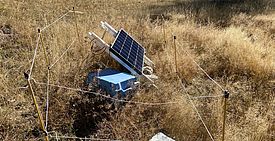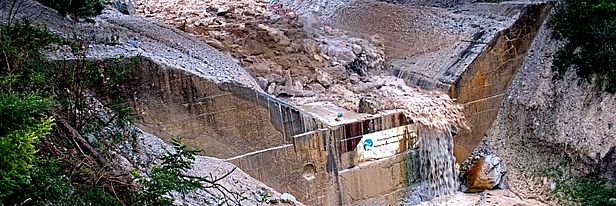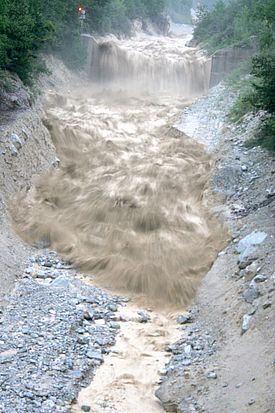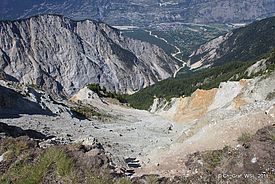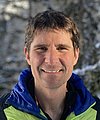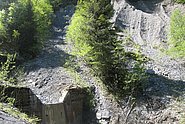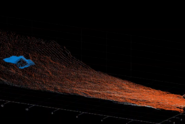Since 2000 the WSL has been observing naturally-occurring debris flows in the Illgraben, an exceptionally active catchment located near the village of Susten (Leuk), in Canton Valais. The site is equipped with measuring instruments that are used to collect information that improve our understanding of debris flows.
Contents ¶
Research at Illgraben ¶
Researchers are studying debris flows in the Illgraben in detail: they are measuring the flow height, and the vibrations and forces exerted by debris flows. From this, the density of the debris flow mixture and the volume of an event are calculated. Various sensors and measuring devices are installed in and around the channel for this purpose. In various projects, the researchers have improved the understanding of debris flows.
Radar sensors and video cameras are mounted on cables above the channel. Some of the cameras are connected to a floodlight for night-time recording. The radar sensors are used to measure the flow height in the channel. Geophones along the channel register vibrations, which are used to estimate flow velocities. Sensors buried near the initiation area measure soil moisture and help explain how debris flows start moving. A debris flow force plate measures the vertical and horizontal forces generated by debris flows.
As part of an innovative project, 3D LiDAR scanners are being used to make images of debris flows. Individual particles of wood or boulders are being tracked, and the local flow depth, flow-surface speed, and discharge are calculated. The researchers use this information to learn about movement within a debris flow.
Seismometers record the vibrations generated by debris flows. They also register mass movements in parts of the catchment that are difficult to reach and where it is not possible to install instruments. They detect debris flows extremely quickly. Using intelligent algorithms that analyse the seismic data in real time, WSL is testing new approaches for alarm systems.
Drone surveys are also being carried out in the Illgraben. Unlike other methods (such as terrestrial laser scanners), drones can cover large areas in a short amount of time. This remote sensing data is used to record changes, such as erosion by landslides or deposition, on the slopes of the catchment.
Assessing dangers ¶
Data generated at Illgraben is also being used by external partners. For example, researchers at Durham University have developed a debris flow erosion model. This is now integrated into the RAMMS:Debrisflow software package. RAMMS simulates the flow of debris flows and is used worldwide to assess hazards and provide a basis for planning protection measures.
Data availability
The main results of the measurements at Illgraben are available on the WSL’s research data portal EnviDAT, and will be updated periodically as methods to interpret the data improve. Publications describing the data, methods, and results are available on DORA and linked below.
Frequent debris flows ¶
While debris flows are rather rare elsewhere, Illgraben has an average of three to five per year. This makes the Illgraben a particularly useful research site. The geological formations and structures in the initiation area, which is characterised by steep slopes and abundant sediment, favour debris flow formation. François Dufour explains how in this short video.
Related topics ¶
Contact ¶
Contact for seismic measurements ¶
Contact for LiDAR measures ¶
Contact for drone flights ¶
WSL publications ¶
Scientific publications ¶
Bolliger D., Schlunegger F., McArdell B.W. (2024) Comparison of debris flow observations, including fine-sediment grain size and composition and runout model results, at Illgraben, Swiss Alps. Nat. Hazards Earth Syst. Sci. 24(3), 1035-1049. https://doi.org/10.5194/nhess-24-1035-2024 Institutional Repository DORA
Aaron J., Spielmann R., McArdell B.W., Graf C. (2023) High‐frequency 3D LIDAR measurements of a debris flow: a novel method to investigate the dynamics of full‐scale events in the field. Geophys. Res. Lett. 50(5), e2022GL102373 (10 pp.). https://doi.org/10.1029/2022GL102373Institutional Repository DORA
Belli G., Walter F., McArdell B., Gheri D., Marchetti E. (2022) Infrasonic and seismic analysis of febris-flow events at Illgraben (Switzerland): Relating signal features to flow parameters and to the seismo-acoustic source mechanism. J. Geophys. Res. F. 127(6), e2021JF006576 (20 pp.). https://doi.org/10.1029/2021JF006576Institutional Repository DORA
Hirschberg J., McArdell B.W., Bennett G.L., Molnar P. (2022) Numerical investigation of sediment‐yield underestimation in supply‐limited mountain basins with short records. Geophys. Res. Lett. 49(7), e2021GL096440 (10 pp.). https://doi.org/10.1029/2021GL096440Institutional Repository DORA
Meyrat G., McArdell B., Ivanova K., Müller C., Bartelt P. (2022) A dilatant, two-layer debris flow model validated by flow density measurements at the Swiss illgraben test site. Landslides. 19, 265-276. https://doi.org/10.1007/s10346-021-01733-2 Institutional Repository DORA
Walter F., Hodel E., Mannerfelt E.S., Cook K., Dietze M., Estermann L., … Molnar P. (2022) Brief communication: an autonomous UAV for catchment-wide monitoring of a debris flow torrent. Nat. Hazards Earth Syst. Sci. 22(12), 4011-4018. https://doi.org/10.5194/nhess-22-4011-2022 Institutional Repository DORA
Walter F., Chmiel M., Hovius N. (2022) Debris flows at Illgraben, Switzerland - from seismic wiggles to machine learning. Geomech. Tunnel. 15(5), 671-675. https://doi.org/10.1002/geot.202200039 Institutional Repository DORA
Wenner M., Allstadt K., Thelen W., Lockhart A., Hirschberg J., McArdell B.W., Walter F. (2022) Seismometer records of ground tilt induced by debris flows. Bull. Seismol. Soc. Amer. 112(5), 2376-2395. https://doi.org/10.1785/0120210271 Institutional Repository DORA
Chmiel M., Walter F., Wenner M., Zhang Z., McArdell B.W., Hibert C. (2021) Machine learning improves debris flow warning. Geophys. Res. Lett. 48(3), e2020GL090874 (11 pp.). https://doi.org/10.1029/2020GL090874Institutional Repository DORA
Hirschberg J., Fatichi S., Bennett G.L., McArdell B.W., Peleg N., Lane S.N., … Molnar P. (2021) Climate change impacts on sediment yield and debris-flow activity in an alpine catchment. J. Geophys. Res. F. 126(1), e2020JF005739 (26 pp.). https://doi.org/10.1029/2020JF005739Institutional Repository DORA
Hirschberg J., Badoux A., McArdell B.W., Leonarduzzi E., Molnar P. (2021) Evaluating methods for debris-flow prediction based on rainfall in an Alpine catchment. Nat. Hazards Earth Syst. Sci. 21(9), 2773-2789. https://doi.org/10.5194/nhess-21-2773-2021 Institutional Repository DORA
McArdell B.W., Sartori M. (2021) The Illgraben torrent system. In E. Reynard (Ed.), World geomorphological landscapes. Landscapes and landforms of Switzerland. Cham: Springer. 367-378. https://doi.org/10.1007/978-3-030-43203-4_25 Institutional Repository DORA
Zhang Z., Walter F., McArdell B.W., de Haas T., Wenner M., Chmiel M., He S. (2021) Analyzing bulk flow characteristics of debris flows using their high frequency seismic signature. J. Geophys. Res. B. 126(12), e2021JB022755 (19 pp.). https://doi.org/10.1029/2021JB022755Institutional Repository DORA
Zhang Z., Walter F., McArdell B.W., Wenner M., Chmiel M., de Haas T., He S. (2021) Insights from the particle impact model into the high-frequency seismic signature of debris flows. Geophys. Res. Lett. 48(1), e2020GL088994 (11 pp.). https://doi.org/10.1029/2020GL088994Institutional Repository DORA
de Haas T., Nijland W., McArdell B.W., Kalthof M.W.M.L. (2021) Case report: optimization of topographic change detection with UAV structure-from-motion photogrammetry through survey co-alignment. Front. Remote Sens. 2, 626810 (9 pp.). https://doi.org/10.3389/frsen.2021.626810Institutional Repository DORA
de Haas T., Nijland W., de Jong S.M., McArdell B.W. (2020) How memory effects, check dams, and channel geometry control erosion and deposition by debris flows. Sci. Rep. 10(1), 14024 (8 pp.). https://doi.org/10.1038/s41598-020-71016-8Institutional Repository DORA
Marchetti E., Walter F., Barfucci G., Genco R., Wenner M., Ripepe M., … Price C. (2019) Infrasound array analysis of debris flow activity and implication for early warning. J. Geophys. Res. F. 124(2), 567-587. https://doi.org/10.1029/2018JF004785 Institutional Repository DORA
Walter F., Burtin A., McArdell B.W., Hovius N., Weder B., Turowski J.M. (2017) Testing seismic amplitude source location for fast debris-flow detection at Illgraben, Switzerland. Nat. Hazards Earth Syst. Sci. 17(6), 939-955. https://doi.org/10.5194/nhess-17-939-2017 Institutional Repository DORA
McArdell B.W. (2016) Field measurements of forces in debris flows at the Illgraben: implications for channel-bed erosion. Int. J. Eros. Control Eng. 9(4), 194-198. https://doi.org/10.13101/ijece.9.194 Institutional Repository DORA
Schürch P., Densmore A.L., Ivy-Ochs S., Rosser N.J., Kober F., Schlunegger F., … Alfimov V. (2016) Quantitative reconstruction of late Holocene surface evolution on an alpine debris-flow fan. Geomorphology. 275, 46-57. https://doi.org/10.1016/j.geomorph.2016.09.020 Institutional Repository DORA
Bennett G.L., Molnar P., McArdell B.W., Schlunegger F., Burlando P. (2013) Patterns and controls of sediment production, transfer and yield in the Illgraben. Geomorphology. 188, 68-82. https://doi.org/10.1016/j.geomorph.2012.11.029 Institutional Repository DORA
Bennett G.L., Molnar P., Eisenbeiss H., McArdell B.W. (2012) Erosional power in the Swiss Alps: characterization of slope failure in the Illgraben. Earth Surf. Process. Landf. 37(15), 1627-1640. https://doi.org/10.1002/esp.3263 Institutional Repository DORA
Berger C., McArdell B.W., Schlunegger F. (2011) Direct measurement of channel erosion by debris flows, Illgraben, Switzerland. J. Geophys. Res. F. 116, F01002 (18 pp.). https://doi.org/10.1029/2010JF001722Institutional Repository DORA
Berger C., McArdell B.W., Schlunegger F. (2011) Sediment transfer patterns at the Illgraben catchment, Switzerland: Implications for the time scales of debris flow activities. Geomorphology. 125(3), 421-432. https://doi.org/10.1016/j.geomorph.2010.10.019 Institutional Repository DORA
Schürch P., Densmore A.L., Rosser N.J., McArdell B.W. (2011) Dynamic controls on erosion and deposition on debris-flow fans. Geology. 39(9), 827-830. https://doi.org/10.1130/G32103.1 Institutional Repository DORA
Badoux A., Graf C., Rhyner J., Kuntner R., McArdell B.W. (2009) A debris-flow alarm system for the Alpine Illgraben catchment: design and performance. Nat. Hazards. 49(3), 517-539. https://doi.org/10.1007/s11069-008-9303-x Institutional Repository DORA
McArdell B., Bartelt P., Kowalski J. (2007) Field observations of basal forces and fluid pore pressure in a debris flow. Geophys. Res. Lett. 34(7), 1-4. https://doi.org/10.1029/2006GL029183 Institutional Repository DORA
Projects ¶
External projects ¶
Framework for Process Cascade Modelling of Rapid Mass Movements
The CCAMM II project at SLF investigates the influence of climate change on alpine mass movements and the associated new challenges. As part of work package 4.3, the researchers are using the Illgraben for testing. They want to find out how to include soil moisture in the prediction of mass movement runoff.
In this project, surface exposure dating of sediments at the Illgraben and in the Rhone River will be used to constrain long-term sediment discharge from the Illgraben. The Illgraben will also serve as a comparative catchment for the other study sites in this interdisciplinary project. WSL Contact: Brian McArdell
The aim of this project at Utrecht University is to decipher the mechanisms of bed erosion through experiments and field measurements. This will allow a more accurate estimation of the volume of debris flows, which will allow a better prediction of the hazards and a better mitigation. The project is also described by a video. WSL Contact: Brian McArdell
Projektname
In this project, which also involves USGS hydrologist Dr. Ben Mirus, we will investigate how debris flows and landslides are triggered in the upper watershed. We are also interested in how water in the channel bed entrains sediments in debris flows - a process that can significantly increase the hazard posed by debris flows.

